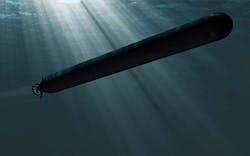Navy taps 24 U.S. defense companies to develop enabling technologies for next-generation UUVs
Officials of the Naval Undersea Warfare Center Division in Newport, R.I., announced a collective contract award Monday for $561.2 million -- with options that could bring the amount to $794.5 million -- to develop and test of UUV technologies and systems by capitalizing on Navy and industry research.
The aim is to find suitable enabling technologies necessary to develop, build, and support the future Navy Unmanned Undersea Vehicle (UUV) Family of Systems (FoS). This project will involve developing core technologies in UUV launch, communications, command and control, navigation, endurance, recovery, payload feasibility, and mission planning.
The list of 24 companies that the Navy selected for this program reads like a Who's Who of undersea warfare specialists. The companies are:
-- Aerojet Rocketdyne in Canoga Park, Calif.;
-- Alion Science and Technology Corp. in Burr Ridge, Ill.;
-- American Systems Corp. in Chantilly, Va.;
-- BAE Systems Electronic Systems in Nashua, N.H.;
-- The Charles Stark Draper Laboratory Inc. in Cambridge, Mass.;
-- DRS Naval Power Systems in Fitchburg, Mass.;
-- General Atomics in San Diego;
-- General Dynamics One Source in Fairfax, Va.;
-- UTC Aerospace Systems in Windsor Locks, Conn.;
-- Huntington-Ingalls AMSEC in Virginia Beach, Va.;
-- Hydroid Inc. in Pocasset, Mass.;
-- L-3 KEO in Northampton, Mass.;
-- Lockheed Martin Rotary and Mission Systems in Riviera Beach, Fla.;
-- MOOG Inc. in Elma, N.Y.;
-- Northrop Grumman Corp. in Annapolis, Md.;
-- Oceaneering in Hanover, Md.;
-- Raytheon Co. in Tewksbury, Mass.;
-- Rite Solutions Inc. in Pawcatuck, Conn.;
-- Science Applications International Corp. (SAIC) in Reston, Va.;
-- SEA Corp. in Middletown, R.I.;
-- Southwest Research Institute in San Antonio, Texas;
-- Teledyne Brown Engineering in Huntsville, Ala.; and
-- Woods Hole Oceanographic Institution in Woods Hole, Mass.
Related: Navy taps Metron to develop machine intelligence for UUV surveillance
Initially these technologies are for the Navy's future extra-large unmanned undersea vehicles (XLUUVs), and later for other kinds of UUVs, Navy officials say. The project also will customize UUV sensor and weapons payloads.
The energy prototyping portion of the project will capitalize on existing independent research and development in energy-dense technology that could meet power requirements for future UUV missions that are limited by the amount of power currently available.
Power efforts will include research, development, test, and evaluation of advanced development model energy solutions initially applicable to XLUUVs for increased energy endurance and efficiency to extend the reach of all unmanned undersea systems.
The common control and autonomy portion of the project will include risk reduction and developmental efforts of autonomy systems and architectures for common standards, interfaces, and systems to support cross-domain applications. The payloads portion of the project focuses on lethal and non-lethal payloads.
These 24 companies will compete for task orders over the next five years, based on their expertise and core technologies. The companies will do the work at various locations, and should be finished by July 2023.
For more information contact the Naval Undersea Warfare Center Division-Newport online at www.navsea.navy.mil/Home/Warfare-Centers/NUWC-Newport.
Ready to make a purchase? Search the Military & Aerospace Electronics Buyer's Guide for companies, new products, press releases, and videos
